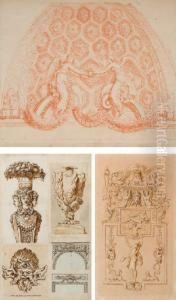Jacques Saly Paintings
Jacques François Joseph Saly, generally known as Jacques Saly, was a French sculptor who was born on June 20, 1717, in Valenciennes, France, which at the time was part of the Spanish Netherlands. He was the son of a local sculptor, which likely influenced his early inclination towards the arts. Saly's initial training was with his father, after which he moved to Paris to further his studies and work. He was admitted to the Royal Academy of Painting and Sculpture in Paris, an important institution for an artist of that era, which provided him with a thorough academic training and access to significant commissions.
Saly won the prestigious Prix de Rome in 1738, a scholarship awarded to promising young artists to study at the French Academy in Rome, which was a crucial opportunity for artistic development. His time in Rome, which lasted until 1740, allowed him to study classical sculpture and the works of the Renaissance, which greatly influenced his style. After his stay in Rome, Saly spent a significant amount of time in Italy studying the great masters before returning to France.
Upon his return to Paris, Saly was received into the Academy as a full member in 1751, and he produced several notable works. His most famous commission was for a statue of King Louis XV, which was intended for the city of Bordeaux. The project was grand and elaborate, requiring several years to complete; the equestrian statue was finally unveiled in 1743. Saly's work was celebrated for its grandeur and its depiction of the king, which reflected the power and confidence of the French monarchy during the period.
Despite his success, Saly moved to Denmark in 1753, where he became the director of the newly established Royal Danish Academy of Art in Copenhagen. His influence on Danish art was significant as he brought with him the classical style of French sculpture and academic training. He continued to work and teach in Denmark until his death on May 4, 1776. Saly's legacy includes not only his own artworks but also his impact on the development of Danish art and the training of a new generation of sculptors. His work is characterized by a blend of Baroque dynamism and classical restraint, and his sculptures are considered prime examples of 18th-century European art.
